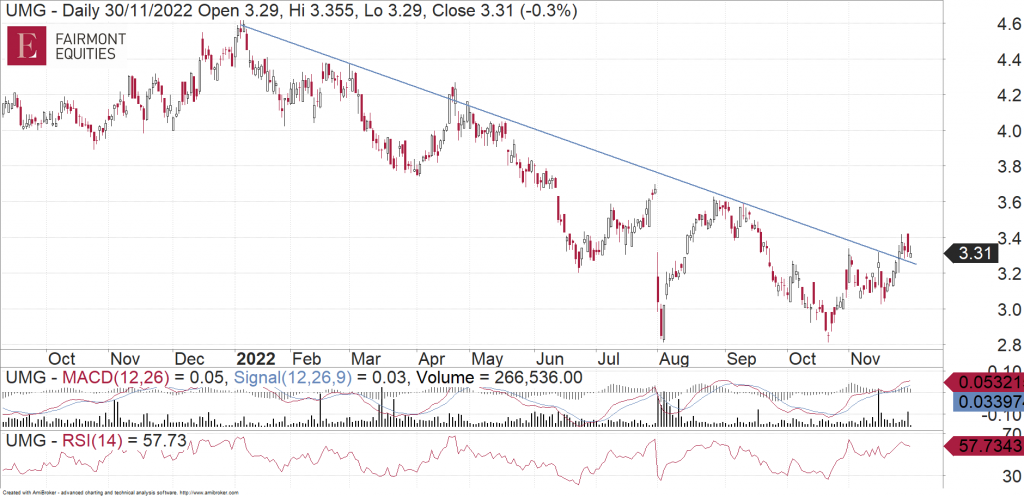We recently researched United Malt Group (ASX:UMG) in The Dynamic Investor after the Company released its result for the 12 months to 30 September 2022 (FY22). The Company had been in an earnings downgrade cycle over the course of FY22. With several factors supporting a return to strong earnings growth in FY23 and beyond, we assessed whether the fundamentals support an opportunity for a recovery trade. While the shares have risen since our recent report, does UMG still present value at current levels?
About United Malt Group
United Malt Group is the 4th-largest global malt producer, with operations in four countries and a diverse customer mix. The primary use for malt is for brewing beer, which accounts for >90% of demand. The Company operates through two segments:
i. Processing (~60% of group EBITDA in FY22), which comprises the Company’s 12 malt plants that have capacity to process about 1.25Mt of malt annually, or roughly 5% of global production.
ii. Warehousing & Distribution (~40% of group EBITDA in FY22). UMG owns distribution and warehousing businesses, serving mainly craft brewers and distributing a variety of supplies such as malt, hops, yeast, adjunct grains and kegs. UMG distributes these products through 22 warehouses in North and South America, Europe, Asia and Australia. It also sells malt to the whiskey distilling industry.
Key Fundamental Drivers
Better Pricing & Commercial Terms to Support Earnings
The Company has implemented substantial changes to pricing and commercial terms for its North American Processing customers. As these re-negotiated terms come into effect progressively in calendar 2023, the Company will better capture the true cost to serve customers which takes into account crop quality, barley price and cost inflation and will be in a position to manage margin risk better.
UMG reiterated that the 1Q23 period will continue to be affected by the 2022 pricing issues given its Processing contracts are rolled over on 1 January 2023. Around 70% of volume for FY23 is priced and as such, the full benefit from improved pricing and commercial terms is expected in FY24.
Even on long-term agreements, UMG have barley prices resets, freight costs resets, and higher energy costs in pricing of contracts with a number of contracts to FY24 already renegotiated where those customers have assumed shared responsibility.
Demand Conditions Are Improving
UMG notes that industry fundamentals remain positive. Despite inflationary cost pressures, UMG said beer demand remains resilient. Importantly, premiumisation trends remain intact and consumers continue to trade up. Malt whiskey production is also expected to continue its upward trend and demand for distilling continues to grow given customers lay down spirits for +10 years for aged whiskey.
Distilling sales volumes continue to increase, reflecting ongoing demand and the additional capacity from UMG’s expanded facilities. Beer consumption has not typically been significantly impacted in periods of recession while demand for craft beer and ancillary products continues to grow.
Input Costs Are Easing
Barley accounts for ~70% of total malt production costs and is UMG’s largest variable cost. In FY22, drought conditions in Canada significantly reduced barley quality. This effect led to reduced yields and higher production costs, as the Company incurred additional logistics costs to import barley into its processing plants in Canada from Denmark and Australia.
Accordingly, improving crop conditions in Canada reduces the impact of higher freight and distribution costs in FY23 given UMG doesn’t have to import barley. Freight costs have been declining, US natural gas prices have fallen since August on a rapidly shrinking inventory deficit and natural gas prices in Europe have also slumped since August on warm weather and close to full gas storage.
Gearing Expected to Revert Back to Target Range
The increase in gearing (on a net debt to EBITDA basis) as at 30 September 2022 was unexpected, given that the Company had indicated in a trading update in April that gearing at the end of FY22 would be in the range of ~2.5–3.0x. Gearing as at 30 September 2022 increased to 5.0x, up from 3.2x as at 31 March 2022 and 2.1x as at 30 September 2021.
The higher gearing position reflects additional inventory financing associated with importing barley given the North American drought and the intake of barley for its UK expansion. Gearing metrics were made worse by a lower A$ on US$ debt on translation.
UMG expected gearing to revert to the target range in FY23, which is likely to be achieved via: i) Significantly higher earnings from 2Q23, ii) A material step-down in CAPEX in FY23, iii) Factoring arrangements and improved cash levels, as the need to import higher priced barley and the timing of the new Inverness facility impacted UMG’s working capital position in FY22.
Is There a Risk of An Equity Raising?
The Company believes that it will not need to raise additional capital and will be within its target gearing range by the end of FY23. However, it is worth noting that:
i. UMG had to undertake an equity raising in June 2020 when gearing at the time (~3x) was much lower than current levels but still above the target range.
ii. There is a risk that a new CEO raises capital to deleverage the balance sheet and position UMG to take advantage of new growth opportunities. Having said that, there is no timeframe on the appointment of a new CEO to replace Mark Palmquist (who remains in his role until a successor is appointed).
Fundamental View
Notwithstanding the improvement in the share price since our recent report, we continue to see potential for further upside in UMG shares. The shares are currently trading on a 1-year forward P/E multiple of ~30x (28x at the time of our report). While this is above the average multiple of ~20x over the last two years, it is worth noting that:
• The Company is not expected to get back to more ‘normal’ earnings until FY24 due to impacts relating to the Canadian drought, supply chain impact on Processing sales, and Processing input costs. As such, the P/E multiple on a FY24 basis is considered a more appropriate valuation measure and to this end, the FY24 multiple of ~16.5x is still at a discount to the average multiple over the last two years.
• The consensus EPS growth profile out to FY25, while significant (+85% over FY22-25 on a CAGR basis), is not fully factoring in earnings growth potential from FY24, given execution risks in the current financial year (FY23) around issues such as: i) Successful implementation of dynamic pass-through mechanisms, ii) Whether the targeted revenue and cost benefits from the Transformation Program can be achieved and iii) Plans to reduce gearing via methods other than an equity raising.
Charting View
UMG had been in a downtrend all year, but it is now breaking it. Firstly, in October it retested the August low and bounced off it nicely to form a double bottom. It then congested under the downtrend line in preparation of an upside break. Pushing beyond the downtrend line is now making this a buying opportunity.

Michael Gable is managing director of Fairmont Equities.
Current share prices available here.
You can learn more about technical analysis in this article.
An 8-week FREE TRIAL to The Dynamic Investor can be found HERE.
Would you like us to call you when we have a great idea? Check out our services.
Disclaimer: The information in this article is general advice only. Read our full disclaimer HERE.
Like this article? Share it now on Facebook and Twitter!

